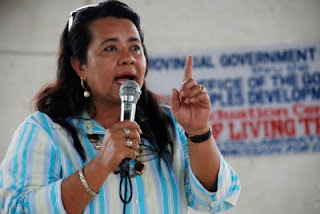By Russtum G. Pelima, Ma. Ed.
MALUNGON, Sarangani (July 2, 2009) – Not too many of us, lowlanders,
known to have been bearers of education for the lumads of Mindanao a
few decades ago, have as much love for education as severally an
indigenous people’s community here find their place of freedom.
In a village some five kilometers from the highway, the road to
Lamlifew wants wear. Yet somehow, the Lamlifew Elementary School had
shown what it takes to win education and break the bondage of poverty.
Patience bore the village 14 professionals which numbers most of the
young professionals in the whole of barangay Datal Tampal.
Celebrating for the first time the school’s foundation anniversary
Wednesday (July 1), now on its 13th as an elementary school (but 27th,
to include its first 14 years as a primary school), teachers and the
community reminisce their forbearing past with joy.
By lunch, they, together with the pupils, have a buffet of two litson
baboy, chicken dishes, and other native delicacies. Yesterday,
community volunteers fixed the road to the school including putting
planks against river Bluan for familiar guests like us.
For the first time, the village has a float parade: 13 beautiful
lasses will compete for Little Miss Lamlifew in the afternoon.
The floats are ornamented with wild, familiar flowers that grew by the
riverbanks and the school grounds, with three most handsome carabaos
because they, too, were ornamented.
The floats are actually the karo (carts) used by the villagers for
many purposes. Today, they are going to cross the river to finish the
parade and reach the school.
The school program includes telling the school’s history. Evelyn Caya,
recalling how the school started, said it’s the villagers’ search for
freedom from want and thirst for education that made the school exist.
For one, the native-grown Florencia Bago, now teaching Grades V and VI
as combined classes (because of lack of teachers) was once a school
volunteer teacher. From 1987-1989, Ma’am Flor received P10 from each
parent. That made up her salary for the whole school year.
Flor tells dreams of her late father made her come back to the village
and help the community by teaching at the school again.
In 2007, school head Marilyn Falsario led parents and pupils to a
food-for-school program by raising poultry and backyard vegetables.
Parents cook for the children’s lunch while the provincial government
afforded them rice.
I believe, scores of these teachers were then “called” to give the
community what they need. Evelyn Caya herself, now a dentist, grew
here, finished her elementary at the school like her husband, Ireneo,
who is now a school cluster head.
Sarangani last year launched the Quality Education for Sarangani Today
(QUEST) project, a brainchild of Synergeia Foundation. Lamlifew
Elementary School is a recipient of its free-workbook distribution for
primary pupils all over the province.
“When I was a child like you, I used to gather kangkong leaves from
the ponds and sell them from house to house for my baon, just to get
back home with the same number of bunches because it would always
rain,” Analie Edday, with teary eyes, recounted in front of children
and parents.
“That day, I made a promise to myself: I shall never be a vegetable
seller all my life!”
Edday, a pure-blooded Blaan, is now QUEST’s program manager.
There must be more to the need for education among the villagers of
Lamlifew, having seen the place myself.
Obviously, it’s one reason why new school head Romeo Bogador doubted
the school’s child-friendly slogan after having realized the danger
among kids crossing the river just a few steps away from the
classrooms especially during heavy rains.
Bogador humbly asks local officials for the construction of a
footbridge to put away their fear.
The school event also launches a beads making class.
Beads making is one of Blaan’s traditional practices. They use them as
body ornaments. Manager Beth Farnazo of the province’s indigenous
people development program initiated the integration of the school of
living tradition to the school’s Makabayan regular curriculum. The
program includes honorarium for the cultural masters in beads making.
Truth is many of them are masters of their own old craft. Herminia
Lacna, a Blaan grand, has preserved the folktales of her tribe by word
of mouth.
For the elderly woman, as the tribe learns, the river speaks in Lamlifew:
“Long time ago,” Herminia narrates, “there was no river here. But a
dog named Kay-kay got thirsty and tried to dig a water spring at the
place called Datal Barak where a mysterious jackfruit seed grew and
has died. Kay-kay drank from the spring and as the dog dug deeper,
more water flowed from the spring that keeps the river running until
now.” (Russtum G. Pelima/SARANGANI INFORMATION OFFICE)

















































